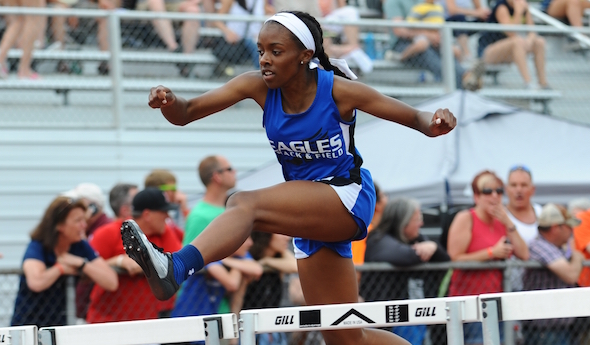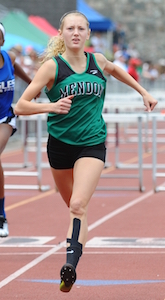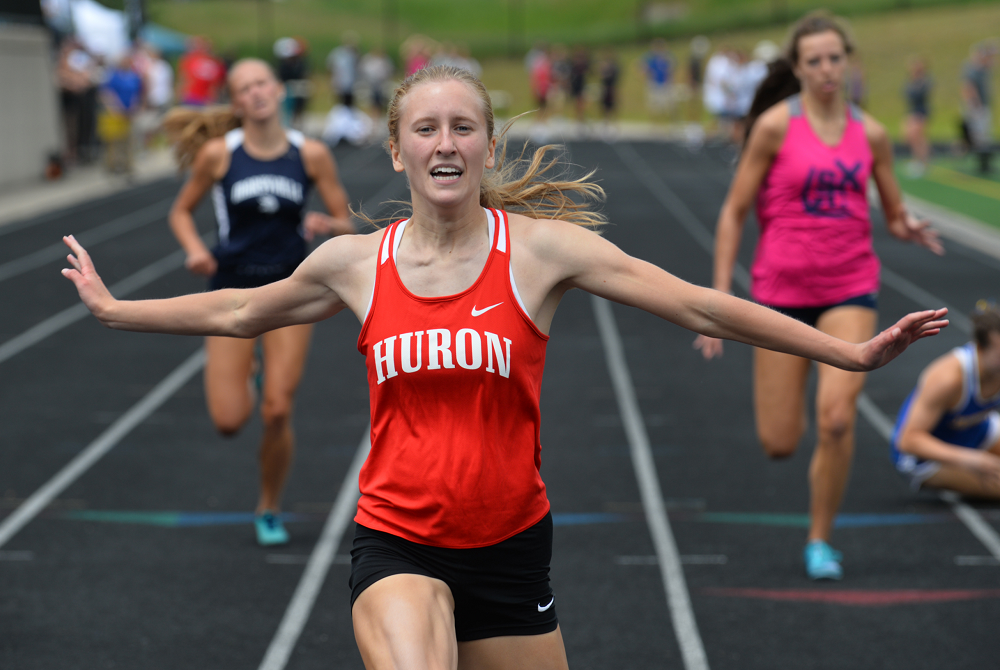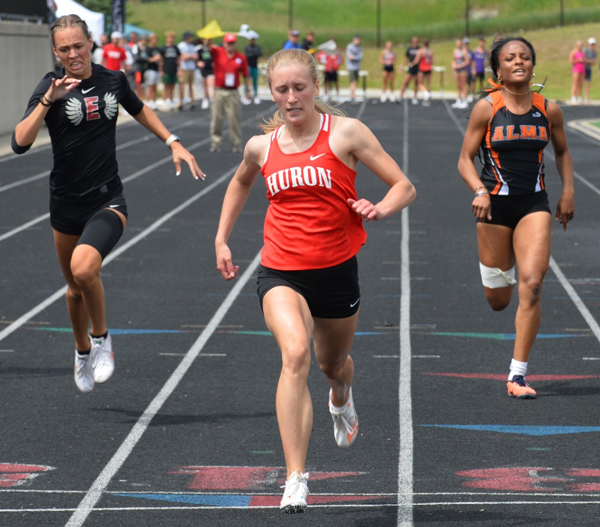
Southfield Christian '6' Claim 1st Track Title
By
Wes Morgan
Special for MHSAA.com
June 3, 2017
GRAND RAPIDS – Southfield Christian may not have a track, but it has a trophy case.
And after Saturday’s Lower Peninsula Division 4 Finals at Grand Rapids’ Houseman Field, the Eagles have a new piece of hardware to put in it.
With great efficiency, a squad of six athletes collected 62 points for the team title to beat out nearest competitors Fowler (52) and Springport (45). It’s the first track & field championship in school history (the Eagles were second in 2007), and junior Chika Amene left her fingerprints all over it.
Amene won three individual events and ran a leg on the first-place 1,600-meter relay team that set a school record with a time of 4 minutes, 7.37 seconds.
“It’s all so surreal,” she said. “I’m speechless, and it’s shocking.”
In the 100 prelims, Amene stumbled out of the blocks but still managed to win her heat. She ran a time of 12.71 seconds in the finals to edge Springport’s Katelynn Creger by four hundredths of a second.
In the 200, Amene clocked a 26.07 to hold off Custer Mason County Eastern’s Jordan Goodman, who ran a personal-record of 26.13.
Finally, Amene claimed her third sprint title when she crossed the finish in 58.83 in the 400. She helped solidify the team championship along with Rebekah Wilson, Kaelin Ray and Shelby Goodson with a convincing win in the 1,600 relay.
“This year I became more focused, and I became more serious,” Amene said. “I became more eager to win and have more of a fight than I did last year. I started training last summer and the indoor season really helped me improve. I want to do it again next year, defend my titles and improve my times.”
 Ray turned in a school record 45.98 to win the 300-meter hurdles, and she placed third in the 100 hurdles with a time of 15.61. The Eagles’ 800 relay of Goodson, Grace Sanders, Ray and Grace McFerrin was third overall in 1:49.10.
Ray turned in a school record 45.98 to win the 300-meter hurdles, and she placed third in the 100 hurdles with a time of 15.61. The Eagles’ 800 relay of Goodson, Grace Sanders, Ray and Grace McFerrin was third overall in 1:49.10.
“We weren’t expecting anything close to this,” Amene said. “I know people back at home are very happy.”
Mendon’s Mary Leighton was expecting nothing short of a championship in the 100 hurdles after setting a meet record in her win as a junior in 2016. Not only did she repeat as a senior, her time of 14.89 was again the best performance in Division 4 history. Leighton also had a runner-up finish in the 300 hurdles with a time of 47.52.
“I like warm weather, so I felt good going over the hurdles,” Leighton said. “I’m happy that I got my (personal record) on my last race of my high school career. As for the 300s, I knew that it was going to be a really close race. I’m still proud of my performance. It’s nice to finish strong before I go into collegiate competition (for Indiana Tech). I will always cherish the memories made from track, and I’m proud to say I ran for Mendon.”
Erika Lechner of Harbor Springs ended her prep career on the highest of notes with a Division 4 meet record toss of 44 feet, 1½ inches. She bested Jade Madison’s mark of 43-8¼ set by the former New Buffalo standout in 2014.
The rest of the meet was a free-for-all as Fowler was one of two other teams to win multiple events. Its 400 relay team of McKenzie Feldpausch, Ciera Weber, McKenzie Koenigsknecht and Sidney Horak grabbed the top spot in 51.49 seconds, and teammate Allyssa Vandegriff cleared 5-4 to win the high jump by two inches.
Pittsford senior Maddie Clark crushed the field by over 15 feet with a distance of 137-6 in the discus, and the Wildcats nabbed another title when Katie Clement went 10-6 for a nine-inch victory in the pole vault.
PHOTOS: (Top) Southfield Christian's Kaelin Ray clears a hurdle during her winning 300 performance. (Middle) Mendon's Mary Leighton powers through her first-place finish in the 100 hurdles. (Photos by Dave McCauley/RunMichigan.com.)

Multi-Sprint Champ Racing to Finish Huron Career Ahead of the Rest Again
By
Keith Dunlap
Special for MHSAA.com
May 25, 2023
NEW BOSTON – If there was one thing Elizabeth Anderson took pride in elementary school, it was simply showing that she could outrun everyone in sight.
 In fact, Anderson has an explanation for all the success she had in those playground races.
In fact, Anderson has an explanation for all the success she had in those playground races.
“Dominance when you are in elementary school,” Anderson quipped. “I don’t think I ever had a nickname. I just think everyone knew I was fast.”
Years later, pretty much everyone who follows track & field in the state of Michigan can attest to that.
A senior for New Boston Huron, Anderson has been faster than most other competitors in the state during her three-year high school career (with her freshman season in 2020 canceled due to COVID-19).
Last year, Anderson won titles at the Lower Peninsula Division 2 Finals in the 200-meter (25.07) and 400-meter (56.28) dashes, and was runner-up in the 100-meter dash (12.23).
Often, top sprinters focus on one or two of those three races. But Anderson is certainly a different breed of sprinter because she does all three.
In fact, she holds school records in all three of those events, and if all that weren’t enough, Anderson is a part of all three sprint relay teams.
“It is hard to give her events off,” said New Boston Huron head girls track coach Danielle Lobato.
Despite the different styles the 100, 200 and 400-meter dashes present, Anderson said there usually isn’t much adjusting when she goes from one of those races to another.
 The strategy is simply, “Let’s beat the other girls to the finish line.”
The strategy is simply, “Let’s beat the other girls to the finish line.”
“I don’t really go into each race changing up how I would run,” she said.
While enjoying and succeeding in all three races, Anderson said she actually does have a favorite among them.
“I would say the 400 is probably my favorite,” she said. “Even though it hurts, it’s satisfying to see how much you can get your time down in the 400 compared to any other race.”
Anderson said she started running track in sixth grade, but really got serious about it during the summer after her sophomore season, when she was invited to run for a local club.
Eventually, that led to her competing over the winter in indoor events.
She lived and breathed track so much that last fall, she decided to not run cross country so she could focus on a weightlifting regimen aimed at developing more leg strength.
“Once I started doing summer track, I realized I wanted to be doing this all the time,” she said.
Lobato said oftentimes in practice, Anderson is a de facto coach, given there is no better person she can think of for the younger runners on the team to learn from.
“I can’t always demonstrate these things I’m trying to teach,” she said. “You get to see it in real life (from Anderson), not in a YouTube video.”
After winning the 100, 200 and 400-meter dashes at her Regional meet last week, Anderson has her sights set on achieving the same trifecta of titles at next Saturday’s Finals in Grand Rapids.
Anderson has signed to run track at Michigan State, but has been plenty motivated to keep producing this spring in her final high school season.
“I’m really looking to defend my titles,” she said. “That is what is really motivating me to keep going. I want to keep in shape for the college season. I don’t want to lose any of the progress I have made. Ultimately, I just love running track.”
And since elementary school, Anderson has loved — and succeeded in — outrunning everyone else to the finish line.
“We knew we were getting something special,” Lobato said of when Anderson arrived in high school. “But you never expect this. All that she has accomplished is amazing.”
 Keith Dunlap has served in Detroit-area sports media for more than two decades, including as a sportswriter at the Oakland Press from 2001-16 primarily covering high school sports but also college and professional teams. His bylines also have appeared in USA Today, the Washington Post, the Detroit Free Press, the Houston Chronicle and the Boston Globe. He served as the administrator for the Oakland Activities Association’s website from 2017-2020. Contact him at [email protected] with story ideas for Oakland, Macomb and Wayne counties
Keith Dunlap has served in Detroit-area sports media for more than two decades, including as a sportswriter at the Oakland Press from 2001-16 primarily covering high school sports but also college and professional teams. His bylines also have appeared in USA Today, the Washington Post, the Detroit Free Press, the Houston Chronicle and the Boston Globe. He served as the administrator for the Oakland Activities Association’s website from 2017-2020. Contact him at [email protected] with story ideas for Oakland, Macomb and Wayne counties
PHOTOS (Top) New Boston Huron's Elizabeth Anderson clears the finish line during last season's LPD2 400 race. (Middle) Anderson, middle, outpaces the field to also win the 200. (Click for more from RunMichigan.com.)

